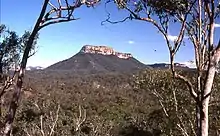Capertee Valley
The Capertee Valley (pronounced Kay-per-tee) is a large canyon in New South Wales, Australia, 135 km (84 mi) north-west of Sydney that is noted to be the second largest (in terms of width) of any Canyon in the world, toppling The Grand Canyon.[2][3] It's located 135 km (84 mi) kilometres north-west of Sydney, between Lithgow and Mudgee, in the Central Tablelands, just above the Blue Mountains.
| Capertee Valley | |
|---|---|
.jpg.webp) View from the southern side of the valley | |
| Width | 30 km (19 mi) |
| Depth | 1.6 km (1 mi) |
| Geology | |
| Age | Triassic |
| Geography | |
| Location | New South Wales, Australia |
| Population centers | Glen Davis |
| Borders on | South Eastern Highlands |
| Coordinates | 33°2′54″S 150°8′4″E [1] |
| Topo map | Wallerawang 8931 (1:100000) |
| Traversed by | James Blackman |
The only population centre of any kind is the village of Glen Davis, which includes a camp-site and often serves as a starting-point for bushwalks around the Capertee River and other parts of the Wollemi National Park.
Geology
The valley follows the Capertee River as it cuts through the Sydney Basin, a sedimentary basin consisting of Permian and Triassic sedimentary rock west of the Blue Mountains. Sandstone cliffs and limestone formations predominate the escarpment, which descend into a deep chasm sculpted into the environment over millions of years.
One of the most prominent features of the valley is Pantony's Crown, a sandstone butte that is now part of the Gardens of Stone National Park. Capertee Valley is only 1 kilometre wider than the Grand Canyon, but not as deep.[4]
History

Aboriginal
The original inhabitants of the land surrounding the valley were the Aboriginal Wiradjuri people, as shown by the 2,000-year-old rock art in the area which feature stencilled hands, boomerangs and throwing sticks.[5]

European
The canyon was first crossed by English explorer James Blackman in 1821. In the 1840s, sheep farming in the area produced quality wool. The area is patterned with old bush tracks, bridle paths and dray tracks from Nulla Mountain to Putty. From 1851, the Australian gold rush increased the colony's population where the Capertee Village developed from small accommodation inns. The area's wealth and value grew as coal, shale-oil and limestone were discovered and mined there.
In 1882, the railway was established, in addition to new homes, inns, a post office and the Glen Davis Shale Oil Works, a shale oil extraction. The village became a rest stop for travellers to Mudgee due to the good water supply in the area.[6] Henry Lawson mentions the valley in his 1891 poem Song of the Old Bullock Driver. In 1920s, bushrangers hid their stolen cattle in the valley. The valley gained importance in the 1930s for its immense geological deposits that laid beneath it and an art deco hotel was constructed.[7]
Birds
The valley is classified by BirdLife International as an Important Bird Area because it is the most important breeding site for the endangered regent honeyeater. It also supports populations of the painted honeyeater, rockwarbler, swift parrot, plum-headed finch and diamond firetail.[8]
In the US published book Fifty Places to Go Birding Before You Die, author Chris Santella lists Capertee Valley as one of only two locations in Australia selected in his top 50 world bird watching locations.[9]
See also
References
- "Capertee Valley". Geographical Names Register (GNR) of NSW. Geographical Names Board of New South Wales. Retrieved 29 October 2010.

- David Fitzsimons (14 December 2015). "Capertee Valley: Australia's own Grand Canyon". Dailytelegraph.com. Retrieved 28 March 2016.
- Dr. Karl S. Kruszelnicki (22 May 2012). "Grand Canyon is not so grand › Dr Karl's Great Moments in Science (ABC Science)". Abc.net. Retrieved 28 March 2016.
- "The Sydney Basin". Australian Museum. Retrieved 26 December 2009.
- "Capertee Valley Today". Lithgow Tourism. City of Lithgow. 19 August 2011. Archived from the original on 13 July 2011. Retrieved 25 January 2013.
- Capertee Tourism Lithgow, NSW Australia
- A grand canyon all our own Traveller
- "IBA: Capertee Valley". Birdata. Birds Australia. Archived from the original on 6 July 2011. Retrieved 12 June 2011.
- Santella, Chris (2007). Fifty Places to Go Birding Before You Die. New York: Stewart, Tabori & Chang. ISBN 978-1-58479-629-9.
External links
| Wikimedia Commons has media related to Capertee Valley. |
